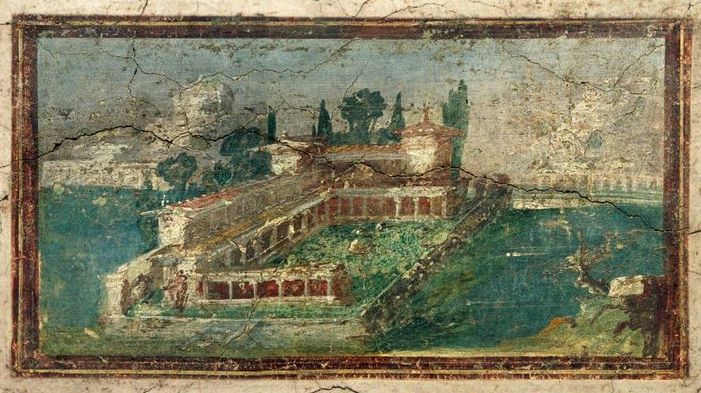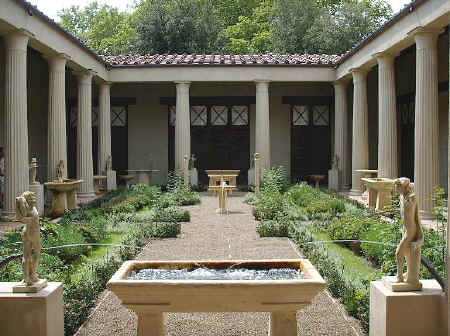Villas of Ancient RomeThe term "Tuscan villa" is sometimes applied rather indiscriminately to any largish house located in the region of Tuscany (or even in Florida), not rarely by the rental real estate industry. In fact, a villa was originally a Roman country house built for a member of the upper classes or imperial family. Pliny the Elder divided villas into two kinds, the villa urbana, which was a country seat that could easily be reached from Rome (or another city) for a night or two, and the villa rustica, the farm house estate, permanently occupied by the slaves and the factor who had general charge of the estate, centred on the villa itself which might be only seasonally occupied. There was a concentration of Imperial villas near the Bay of Naples, especially on Capri, at Monte Circeo on the coast and at Antium (Anzio). Wealthy Romans escaped the summer heat into the hills around Rome, especially near Tivoli where Hadrian's Villa is located. Cicero is said to have possessed no fewer than seven villas, the oldest of which was near Arpinum. Pliny the Younger had three or four, of which the example near Laurentium is the best known from his descriptions.
Roman painting of a marine villa The
inspirations for the form and organisation of Renaissance villa architecture may
be found in the literary descriptions provided by the authors of ancient Rome.
In particular,
Columella (4–70 A.D.) in
De re rustica and Cato (234–149 B.C.) in De agricultura elaborate on the features of their villas in the
Campagna, the low-lying area surrounding Rome. Commonly
in ancient writings, the villa exerts restorative powers due its natural setting or
otium, in
contrast to the excesses of city life, or negotium.
Horace (65–8 B.C.) extolled the simple virtues and pleasures of ancient villa life in his poetry. Reconstruction of the Roman garden of the House of the Vettii in Pompeii Roman writers refer with satisfaction to the self-sufficiency of their villas, where they drank their own wine and pressed their own oil, not unlike the foreign inhabitants of Tuscany today. The villa thus holds a central place in the history of Western architecture. On the Italian peninsula in antiquity, and again during the Renaissance, the idea of a house built away from the city in a natural setting captured the imagination of wealthy patrons and architects. While the form of these structures changed over time and their location moved to suburban or even urban garden settings, the core design tenet remained an architectural expression of an idyllic setting for learned pursuits and spiritual withdrawal into a domestic retreat from city life. Renaissance Villas near Rome
The architecture and landscape elements described by Pliny the Younger appear as part of the Roman tradition
as embodied in the monumental Villa
Adriana. Originally built by
the Emperor Hadrian in the first century A.D (120s–130s), the villa extends across an area of more than 300 acres as a villa-estate combining the functions of imperial rule
(negotium) and courtly leisure (otium). Having fallen into ruin, the vast archaeological site was recovered in the
15 C and many architects
- including Francesco di Giorgio Martini (1439–1501/2), Andrea Palladio (1508–1580), and
Pirro Ligorio (ca. 1510–1583) - excavated and recorded firsthand the details of Hadrian's design while consulting descriptive passages of the emperor's life at the villa from the
Historia Augusta. Most notably, the architect-antiquarian Ligorio employed sculptural remains of the Villa Adriana in the
Vatican gardens and as architectural spolia in his design of the nearby
Villa d'Este (begun 1560). Ligorio's design for Cardinal Ippolito II d'Este (1509–1572)
was one of the most splendid garden ensembles in Renaissance
Italy and remains celebrated for its festive waterworks and terraced gardens. Like the descriptions of ancient villas consulted by Renaissance architects, the Villa d'Este commands spectacular vistas over the Roman campagna from its position high in the hills of
Tivoli
above the Villa Adriana. |

